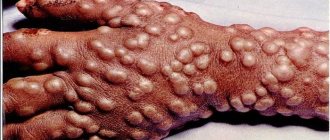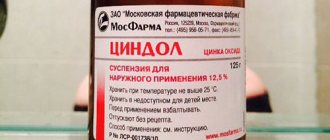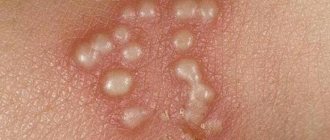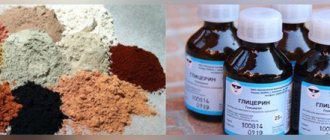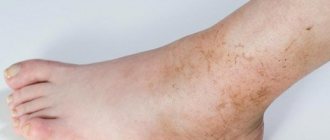For the treatment of skin diseases that are accompanied by inflammation and require drying, zinc-containing preparations are best suited. Zinc has anti-inflammatory, antiseptic, wound-healing and antioxidant effects. The modern market offers a wide selection of products that contain zinc, for example, Tsindol and Calamine. Both of these medications are quite popular and are often prescribed by dermatologists.
What does the medicine consist of?
The basis of this remedy for chickenpox is the following components:
- Purified water. Gives the suspension a liquid form.
- Zinc oxide. Main active ingredient. Preparations based on zinc oxide are widely used in dermatology for the treatment of skin diseases: psoriasis, chickenpox, and so on. The essence of the therapeutic effect is to reduce the proliferative activity of cells at the local level. It has a pronounced antiseptic effect and relieves inflammation.
- Talc. Necessary to impart viscosity to the drug. It also has some calming effect, reducing itching.
- Glycerol. Used to create a viscous texture of the drug.
- Ethanol (aka ethyl alcohol at a concentration of 70%). Powerful local antiseptic.
- Starch.
The use of Tsindol for chickenpox in children is effective only due to the content of zinc compounds. At the same time, when the metal oxide comes into contact with the structures of the papule, albuminates are formed - special substances that have a softening and soothing effect on the dermis.
When prescribed:
- Chickenpox,
- Cuts and abrasions
- Dermatitis of various natures,
- Ulcers,
- Herpes,
- Eczema,
- Burns,
- Diaper rash.
There are no specific contraindications to the use of cindol. It is not used if the components are intolerant.
The drug is approved for use against chickenpox in young children, women during pregnancy and breastfeeding.
- Before use, you should conduct a tolerance test by smearing a small piece of your body. If there is no allergic reaction after an hour, the product can be used on the entire skin.
- Tsindol is intended for external use only; mucous membranes are not treated with it.
- The medicine for chickenpox cannot be used after the expiration date; it must be stored out of the reach of children.
Tsindol suspension is used to treat chickenpox in children and adults, in whom the disease is much more severe. But this drug is effective not only against infections caused by the herpes virus.
Tsindol is successfully used for atopic and allergic dermatitis, bedsores, scabies, pityriasis rosea, nail fungus, and demodicosis. Read about the treatment of demodicosis on a person’s face here.
The medicine fights inflammation of the skin and relieves severe itching, which is almost always present with skin diseases.
The suspension copes with this problem by soothing the skin. They can also use it after electrolysis.
Tsindol has practically no contraindications as such; the drug should not be used mainly if there is an individual intolerance to its components.
An allergy to the components of the drug is manifested by the following symptoms:
- severe itching;
- skin redness;
- rashes in the treated area.
If such symptoms appear, use of Tsindol should be stopped and consult a doctor.
If intolerance to zinc oxide is established, then all medications that contain it should not be used in the future.
There are no age-related restrictions on the use of the product. Tsindol has been successfully used to treat chickenpox and other skin pathologies in children from birth.
A side effect of repeated application of Tsindol during chickenpox treatment may be that the skin becomes too dry and flaky.
Sometimes after application the skin feels as if it stings slightly. But this does not cause much discomfort; this sensation is easily tolerated even by children and passes quickly.
One of the undeniable advantages of the drug is that it has a minimal number of contraindications and side effects. The product can be used at any age; it can be prescribed to pregnant and nursing mothers after consultation with a doctor.
Do not use the drug under any circumstances if you have a proven intolerance to zinc oxide.
If drugs based on zinc oxide have not been used previously (especially in pediatric patients), then an allergy test should be performed at home.
Apply a thin layer of emulsion on a small area of skin on the inside of the forearm (1 x 1 cm). If irritation and inflammation appear in this area within an hour, then you should stop using the drug in favor of another product that does not contain zinc. If the skin looks “calm”, then you can apply the substance to the affected skin.
Tsindol has only one contraindication: individual intolerance to the components of the drug, which manifests itself as an allergy.
But there are precautions:
- Before use, you need to check for allergies;
- Do not apply a thick layer to the rash, because this can lead to loss of moisture and peeling of the skin.
Instructions for proper use
Correct application requires several steps:
- It is necessary to shake the suspension so that the medicine becomes homogeneous.
- Dry the skin if necessary.
- Apply the medicine in a layer of 0.5-1 mm, carefully treating the affected areas. Cotton swabs work well for lubrication.
- Excess product can be removed using a cotton swab or pad.
- To treat large lesions of chickenpox, cotton wool (a disk or swab, but not sticks) is used. Unlike Fukortsin, massive use of the drug over large areas of skin is allowed .
- It is recommended to use the drug 2-3 times a day. The maximum number of repetitions is 6 times a day.
- Leave the product for several hours, then rinse with regular warm water.
Is it possible not to treat the skin?
The use of local remedies for chickenpox is not a prerequisite for treating such an infection. If you take care of hygiene (bathe your child several times a day, change clothes, wash your hands) and avoid scratching the blisters, the chickenpox rash will heal without a trace and without any treatment. However, if the rash is very itchy and causes great discomfort to the baby, or there is a high risk of infection in the wounds, skin treatment is desirable, because it will help alleviate the condition of the baby and prevent bacterial complications.
https://www.youtube.com/watch?v=lzw_yqzXfhE
You can learn even more about chickenpox from Dr. Komarovsky’s program.
Today we will talk about how to apply chickenpox in different situations. The main task in the treatment of chickenpox is discomfort in the form of itching and heat, but in severe cases of the disease, you will have to use antiviral drugs. Below, after the list of ointments and means for external use, we will provide recommendations, after which it will be clear how much and why to smear chickenpox with green, what can be used to smear chickenpox to relieve itching and fight the virus. We’ll also talk about how many days to apply chickenpox in different cases and whether it is necessary to do it at all.
Before we begin to consider how to smear chickenpox in children in pursuit of certain goals, it is necessary to talk about the rash itself and why it is generally treated with ointments and cauterization agents. In the initial stage, a rash similar to ordinary acne. It appears on the face and then spreads to the torso, arms, legs, mucous membranes of the mouth and the genital area.
If the rash is not treated in advance and scratching is not prevented, the restoration of the skin will be greatly delayed, and scars in the form of scars may remain at the site of the rash. In this regard, treatment of chickenpox should be aimed, first of all, at significant relief of itching and proper care for the sick child.
Precautionary measures
- Tsindol becomes dangerous after the expiration date. The shelf life is 2 years. It is also necessary to comply with storage conditions (temperature no higher than 30 degrees), otherwise the medicine will become unusable much earlier.
- To exclude an allergic response, preliminary local application in small quantities is recommended to assess the body's reaction.
- The drug is used for skin application only. Treatment of mucous membranes is prohibited.
Suspension (mash)
Manufacturers offer Tsindol only in the form of a suspension of liquid consistency, popularly called mash.
The drug is sold in dark glass bottles of 100 and 125 ml. Each bottle is placed in a cardboard package.
Inside the bottle there is medicine in the form of a heterogeneous suspension of white or grayish-white color.
The instructions included with Tsindol recommend shaking the contents of the bottle before use.
There is no such pharmaceutical form as Tsindol ointment. But you can prepare it at home:
- For this purpose, the bottle with the medicine is left in a warm place for some time to form a sediment at the bottom.
- The upper liquid part is drained, and the thick substance is used as an ointment.
- It can be applied to the skin in its pure form or mixed half and half with baby cream.
Tsindol is a drug with a high therapeutic effect and at the same time a very affordable, affordable price.
In different Russian pharmacies, the cost of the medicine is slightly different - you can buy a suspension from 70 to 110 rubles for one bottle.
Unlike the popular and effective remedy - Calamine, Tsindol is more accessible to the majority of the population.
Therefore, parents often give preference to it when the question arises - how to treat chickenpox in children.
Comparison of Calamine and Tsindol
Having difficulty choosing a drug, parents wonder: what is better: Calamine or Tsindol.
| Tsindol | Calamine |
| The main active ingredient is zinc oxide | In addition to zinc oxide, the composition includes iron oxide, which complements the astringent effect and dries out wound surfaces |
| Suspension | Lotion |
This is where the fundamental differences between Tsindol and Kalamine end. These medications are a worthy replacement for each other, so you can choose any without any doubt. The price for Tsindol, on average, is lower than for Kalamine (about 500 rubles difference). In any case, self-medication is not recommended. The best solution would be to visit a pediatrician and/or pediatric dermatologist.
Contraindications
The remedy is indicated for various rashes accompanied by inflammation and itching.
Tsindol is prescribed not only for chickenpox and other types of herpetic rashes, but also for dermatitis, eczema, diaper rash, and ulcerative skin lesions. This drug helps in the treatment of bedsores, temperature and sunburn, prickly heat, streptoderma. It can also be used for damage to the skin, for example, scratches or cuts.
There are no age restrictions for the use of Tsindol - the product can be applied even to the skin of newborns.
In what cases is the use of zindol justified? The medicine is prescribed only by a doctor.
Tsindola cost and reviews
The cost of a pharmaceutical product starts from 70 rubles. The maximum price is 150 rubles. Even compared to Fukortsin and brilliant green, this is not so much money. For an extra 20-30 rubles, the patient receives an effective and, in all respects, safe remedy for the rapid treatment of chickenpox, which clearly speaks in favor of Tsindol. If you believe the reviews of parents and doctors, the medicine is considered highly effective, causes a minimum of side effects, and is also cheap. The only disadvantages noted are the inconvenient pharmaceutical form, and also the fact that Tsindol tends to leave marks on clothes.
For chickenpox, the use of Tsindol is a worthy alternative to the usual brilliant green. The choice is up to the parents.
What to apply?
Chickenpox in children and adults can occur with varying degrees of severity. In particular, the disease can lead to the appearance of only a few elements of the rash and a slight increase in temperature. But sometimes the disease causes severe fever, and almost all the skin and even mucous membranes are covered in rashes.
Regardless of the severity of chickenpox, doctors advise lubricating the elements of the rash with various medications. Such medications are unable to speed up healing or significantly reduce the severity of discomfort. They mainly perform two functions:
- Prevent infection from occurring.
- They help monitor the appearance of new blisters (after all, five days after the formation of the last rashes and their crusting, the patient is considered non-infectious).
For these reasons, classic brilliant green is no longer used in 100% of cases for chickenpox. It is replaced by:
- Tsindolom.
- Methylene blue.
- Fukortsin.
- Calamine.
- Potassium permanganate solution.
- Furacilin solution.
- Salicylic alcohol, etc.
Of course, all of the above products are not suitable for treating the oral cavity. Your doctor will help you choose the most effective drug for lubricating the skin.
Parents' opinion
Parents' reviews of the use of Calamine for chickenpox are mostly positive - the product soothes the skin, relieves itching and has a drying and disinfecting effect, which prevents possible complications.
People who started using it despite contraindications speak negatively about the lotion. Also, users are often dissatisfied with the price, as some consider it too high. It ranges from 600 to 800 rubles. An ointment with this name is characterized by a similar cost.
Calamine can be stored for 3 years. After the expiration date has expired, the product should be thrown away. Its beneficial properties have been lost by this point. After purchasing, you need to place it in a cool and dark place so that it is not exposed to sunlight.
